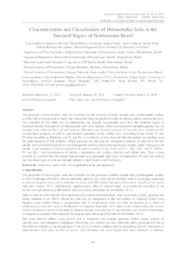Characterization and classification of halomorphic soils in the semiarid region of Northeastern Brazil.
Characterization and classification of halomorphic soils in the semiarid region of Northeastern Brazil.
Autoria: PESSOA, L. G. M.; FREIRE, M. B. G. dos S.; ARAUJO FILHO, J. C. de; SANTOS, P. R. dos; MIRANDA, M. F. A.; FREIRE, F. J.
Resumo: The properties of halomorphic soils are controlled by the presence of either soluble salts, exchangeable sodium or both, and it is important to know and understand these properties in order to reforest and/or recover the soils. The objective of this study was to characterize and classify halomorphic soils from the semiarid region of Northeast Brazil. Four profiles of halomorphic soils were studied, which were described morphologically and the samples were collected from all soil horizons. Physical and chemical analyzes of the soils were carried out for classification purposes, as well as geochemical speciation of the soluble salts. According to the results, P1 and P3 were classified as Fluvisols, and P2 and P4 as Cambisols. It was observed that the studied soil profiles have the predominance of fine particles, which prevents the leaching and subsequent removal of salts from the soil profile. Soils presented high levels of exchangeable sodium, characterizing them as sodium solids throughout the profile. Ionic speciation analysis indicated the predominance of free forms of Ca2+, Mg2+, Na+ and K+, HCO3-, Cl- and SO42- and combinations of calcium, magnesium and sodium chloride and sulfate salts. Thus, it was possible to conclude that the studied halomorphic soils presented high levels of degradation by salts and sodium and that these types of soils are strongly related to the Fluvisols and Cambisols.
Ano de publicação: 2019
Tipo de publicação: Artigo de periódico
Unidade: Embrapa Solos
Palavras-chave: Saline soils, Sodic soils, Soil degradation, Solo Salino, Solo Sódico
Observações
1 - Por padrão são exibidas publicações dos últimos 20 anos. Para encontrar publicações mais antigas, configure o filtro ano de publicação, colocando o ano a partir do qual você deseja encontrar publicações. O filtro está na coluna da esquerda na busca acima.
2 - Para ler algumas publicações da Embrapa (apenas as que estão em formato ePub), é necessário ter, no celular ou computador, um desses softwares gratuitos. Sistemas Android: Google Play Livros; IOS: iBooks; Windows e Linux: software Calibre.
Acesse outras publicações
Acesse a Base de Dados da Pesquisa Agropecuária (BDPA) para consultar o acervo completo das bibliotecas da Embrapa.

